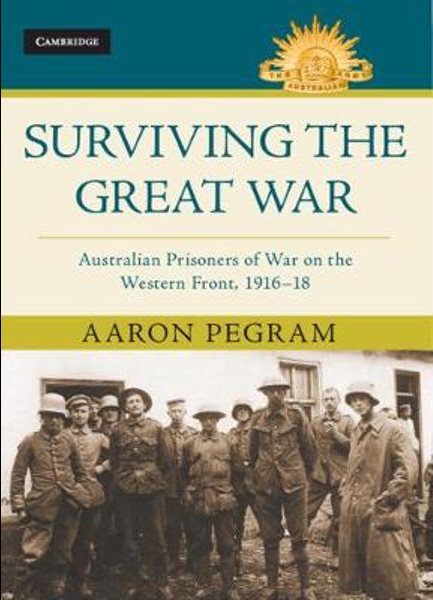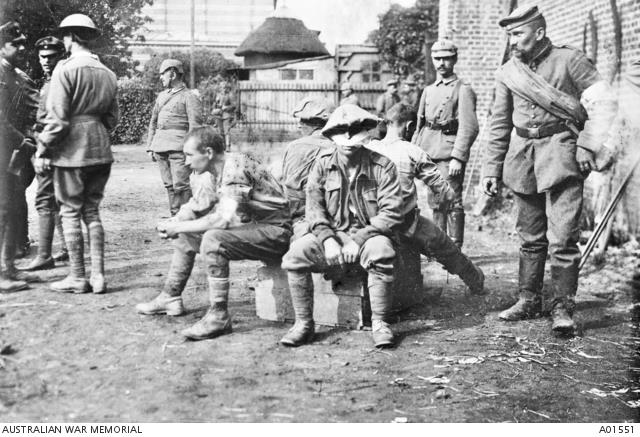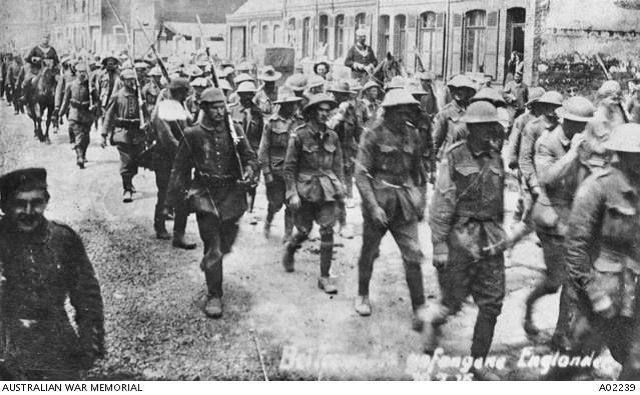From a population of less than five million in 1914, 416,953 Australians volunteered for overseas service in the Australian Imperial Force and 331,781 actually departed these shores.

Of them, 64.8% would become casualties – included amongst which were 4,044 prisoners-of-war, 196 of whom were captured by the Ottomans in the Middle East and 3,848 by the Germans on the Western Front, the first 11 on 5 May 1916. That Australians have paid practically no attention to these POWs is hardly surprising; due in large part to the Anzac Legend, we were conditioned to view the members of the AIF simply in heroic terms, as natural soldiers who were recklessly brave and would be ultimately victorious. Life in captivity, as a POW, did not accord with the original Legend. But times have changed, and we now have had a generation of academic historians whose interests are far removed from those of Charles Bean, who did so much to promote the Legend. And some attention has now settled upon the fate of Australian troops who were taken prisoner by the Germans when fighting on the Western Front.
The book under review here started life as a PhD thesis undertaken at the Australian National University, and won the 2018 CEW Bean Prize for military history, awarded to the best thesis submitted to an Australian university on a topic involving the Australian Army. Its author, Aaron Pegram, is a senior historian at the Australian War Memorial. Surviving the Great War is an academic study, not a popular history. It doesn’t contain heroes and there is no traditional narrative. Its purpose is fairly straight forward: to explain how some Australians came to be captured by their German opponents on the Western Front, and to investigate what life was like for them when in captivity. If you like sustained analysis, you should find this book interesting reading.
It had been found (by Professor Alistair Thompson) that interviews with members of the AIF conducted after the Great War became increasingly unreliable with the passage of time, mainly because the memories of the interviewees were influenced by the (unconscious) addition of aspects of the Anzac Legend – and, in this particular case, potentially by information about how Second World War POWs were treated by the Japanese. So Aaron Pegram made the decision to base his study as much as possible on primary sources produced around the time of the Great War (which are held in the Australian War Memorial). He employs about 50 diaries and accounts written (surreptitiously) by POWs during the war plus 2,500 statements written by them just after the war, once they had been repatriated to England.
Poor morale would be a key factor in the surrender of hundreds of thousands of Germans (especially in the concluding stages of the First World War); similarly, 11.6% of French troops became POWs. Does poor morale explain why Australian troops became POWs? Not according to Pegram: he was able to identify ‘just two Australians who willingly deserted to the Germans’ – Private Allen Yeo, on 1 December 1916, and Private Charles Christiansen, 17 March 1917. Otherwise, in nearly all cases, the surrender of Australian troops to the enemy can be explained by the fact that they found themselves in untenable tactical situations. A typical scenario was that the AIF was involved in an advance which encountered strong German counter-attacks, resulting in units becoming isolated and surrounded, with no ability to withdraw and no option but to surrender ‘when the seemingly futile gesture of fighting meant certain death’. In the Battle of Fromelles of 19-20 July 1916, the AIF’s 5th Division suffered more than 5,500 casualties including 470 taken prisoner by the Germans; in the Battle of Bullecourt of April 1917 the Germans captured 1,170 Australians, the largest number of Australians captured in a single engagement during the war; and around 8 April 1918, during the fighting at Villers-Bretonneux and Dernancourt resulting from Ludendorff’s Spring Offensive, the Germans captured another 400 Australians. Some Australian airmen also became POWs, when forced to land behind German lines.
There was no guarantee that a surrendering soldier would not be killed. But as Pegram explains it, both sides were of the understanding that if you treated their prisoners in an acceptable manner, they would do likewise: ‘Surviving capture was … based on a principle of reciprocity and the knowledge that it was better to accept the surrender of Australian troops than risk the lives of German soldiers who would be forced to surrender to British troops in future engagements’; as a consequence, ‘the German Army generally honoured the surrender of Australian soldiers’ − although they were usually ‘ratted’ for ‘souvenirs’ (such as wallets and watches) and sometimes beaten up upon being captured. As regards prisoners who were suffering wounds when captured, they had a good chance of receiving appropriate medical care and surviving.

According to the Hague Conventions it was forbidden to mistreat prisoners in order to acquire information. And, according to Pegram, Australian prisoners were not subjected to harsh interrogations. When possible, prisoners were interrogated within hours of capture, when they were possibly in a traumatised, disoriented state. German intelligence officers would pay most attention to captured officers and NCOs. They found it was most productive if they assumed a friendly attitude to prisoners: to lull them into a false sense of security, they were treated with sympathy, being offered cigarettes and alcohol. ‘Once prisoners of war were sufficiently assured that no harm would come to them, they often spoke openly and candidly about military matters and disclosed important information about morale, strength and disposition of the AIF and its operations’. A very interesting case involved Captain Charles Mills who was captured during the Battle of Fromelles, on 20 July 1916. His German interrogator required Mills to hand over the contents of his pockets, and this turned up a diary. Upon examination, this was found to contain a copy of orders from British XI Corps headquarters which indicated that the Fromelles attack was nothing but a diversion, not a full-scale operation – a trick designed to pin down Germans forces in the Lille area, and prevent them from redeploying reserves to where the main British attack was proceeding down south on the Somme. (Yet despite discovering this vital piece of intelligence, the Germans did not redeploy their forces.) In the wake of this episode, instructions were issued to the members of the AIF’s 5th Division advising that ‘they were betraying their duty by giving any information other than their name and rank if they shall fall into enemy hands’ – and warning commanders that ‘no documents of use to the enemy’ were to be carried into No Man’s Land. Despite this, the Germans would continue to acquire useful written materials from Australian POWs. On 19 September 1917, Lieutenant Harold Ferguson was captured in No Man’s Land carrying plans for an imminent AIF attack that was part of the Battle of Menin Road. In a repatriated prisoner statement made just after the war he claimed he was able to destroy the plans before being captured – but they were actually retrieved by his captors, who proceeded to take counter-measures. Subsequently Ferguson was charged with having provided the enemy with the plan, but he was cleared after an investigation.

When the Germans found out that their opponents were retaining significant numbers of POWs as forced labourers in locations close to the front line, thus exposing them to the possibility of being hit by artillery barrages, they responded in kind, with ‘reprisals’. As a result, in the six months from April 1917, 1400 Australian POWs were located in forward areas, close behind the front line – where seven would be killed by shell fire. (Eventually the British relented by removing German POWs to work camps 30 kilometres from the front line, and the Germans then did likewise.) It appears the treatment Australians received in such work camps at the hands of regular army personnel was reasonable, but older reservists (known as Etappenschwein, ‘rear-area pigs’) used as guards were prone to employ beatings to coerce work parties. Rations were in short supply in these work camps and diseases – such as dysentery, beriberi, enteritis, pneumonia and malaria − were rampant, resulting in 87 Australian deaths.
According to Pegram: ‘the experiences of prisoners varied dramatically according to chance, circumstances, rank, their ability to work, and the deteriorating situation on the German home front’. There was ‘a diverse range of experiences among prisoners of war, some of whom experienced exceptionally good treatment while [for others it was] exceedingly poor’.
Most Australian POWs were transported directly to Germany which, by the time they began arriving in 1916, had established a network of more than a hundred prison camps – growing to 175 by October 1918. International conventions for the treatment of POWs made a distinction between officers and other ranks: officers would not be required to work; other ranks could be assigned work provided it was not directly related to the war effort, in return for which they would be paid wages. According to Pegram: ‘the principle of reciprocity and the threat of reprisals ensured that the belligerents adhered to the agreements’; and, ‘Germany largely adhered to the pre-war agreements as best it could … [Any] abuse experienced by Australian prisoners of war did not [necessarily] reflect a formal policy of mistreatment’. Some prison camps were reserved for officers − Offizierslager. According to Captain Charles Mills, in the camp in which he was placed, the food was better than he had expected and the guards were ‘uniformly courteous’. Apart from the requirement that he be in attendance at a 9:30 am roll call, he was pretty much free to do whatever he wanted within the prison walls. If he had a complaint it was that he had ‘absolutely nothing to do!’ According to Dr Adolf Vischer, a Swiss doctor who inspected many camps, inmates like Mills suffered from a condition known as ‘barbed wire disease’, caused by the monotony of incarceration and the lack of privacy confinement imposed. The camps for the ‘other ranks’ could contain up to 20,000 inmates. Due to manpower shortages resulting from German conscription, it was increasingly likely these POWs would be assigned to outside work parties in either industry, mining or agriculture – by 1916 more than 90% of POWs were working outside the camps. Industrial work could be dirty and unpleasant. A party of 25 Australians assigned to a quarry were subjected to months of working physically demanding 12-hour shifts, six days a week, and exposed to the possibility of tunnel collapses. Another group worked under similar conditions in a coal mine, for up to 18 hours a day. Attempts to evade such work were met with deprivation of food, beatings and solitary confinement. The most attractive option for the ‘other ranks’ was to be sent to the countryside to work for a farmer as an agricultural labourer. This involved practically no close supervision and possibly allowed considerable freedom of movement.
Due to the very effective blockade enforced by the British Navy, as the war progressed Germany suffered serious food shortages – which partly accounts for the poor rations supplied to POWs. Helping to ameliorate the problem, the Australian branch of the Red Cross Society would be responsible for sending almost 400,000 food parcels to Australian POWs – each containing tea, sugar, condensed milk, biscuits, beef dripping, cheese, oats and three tins of meat. Pegram: ‘the principle of reciprocity and the possibility of reprisals against German prisoners in England ensured the German authorities … allowed the delivery of food to British prisoners’ – at the time it was estimated that 80% of these food parcels were delivered. Incredibly the amount an officer would receive was almost four times that received by other POWs – which is in need of some explanation.
The major conclusion reached by Pegram is that, such was the fighting on the Western Front that: Australian POWs ‘endured German captivity as best as they could, as many possessed little desire to return to the mud and blood of the trenches’, viz. they did not want to escape and resume life with their mates in the trenches. This constitutes a rejection of the key propositions at the heart of the Anzac Legend, that Australian troops were resourceful and predisposed to act heroically, and that mateship was one of their defining characteristics. The evidence cited for such a conclusion is that only two Australian officers and 41 other ranks ever succeeded in escaping, and ‘all Australian prisoners who escaped German captivity elected to return [to Australia] and discharge from the AIF’. (A slight problem with Pegram’s argument here is that official policy was not to allow those who had been POWs to return to active service.) More than 98% of Australian POWs remained in the camps. Pegram: ‘… the comfortable conditions in officers’ camps was a good enough incentive for prisoners to remain where they were … Good treatment and comfortable living in camps gave prisoners of war little desire to return to trench warfare in France and Belgium’. Perhaps not surprisingly, some of the post-war statements written by Australian POWs present a quite different picture, emphasizing mistreatment at the hands of the Germans. Pegram downplays this type of evidence. He effectively dismisses the booklet How the Germans Treated Australian Prisoners of War which the Australian Defence Department published in February 1919 as a piece of propaganda, one purpose of which was to bolster Australia’s case for favourable treatment at the Paris Peace Conference. Pegram does acknowledge that ill health would be experienced by some as a result of their POW experiences – but suggests that many got on with their lives regardless.
Pegram’s book is a prime example of how the writing of a history is a product of its times, sometimes presenting a view of the past differing significantly from that which has long held sway amongst the public.
Reviewed for MHSNSW by David Martin in Reconnaissance, Autumn 2020
Contact MHHV Friend about this article.






